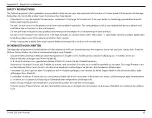
53
D-Link E30 User Manual
Appendix B - Technical Specifications
Technical Specifications
Standards
• IEEE 802.11ax
1,2,3
• IEEE 802.11ac
1,2,3
• IEEE 802.11a
• IEEE 802.11n
• IEEE 802.11g
• IEEE 802.11b
• IEEE 802.3u
• IEEE 802.3ab
• IEEE 802.11k/v
Wireless Frequency Range
2
• 2.4 GHz to 2.4835 GHz
• 5.18 MHz to 5.85 MHz
Device Interfaces
• 802.11ax/ac/n/g/b/a Wireless LAN
• 10/100/1000 Gigabit Ethernet Port
• Reset Button
• WPS Button
Wireless Security
• WPA3/WPA2/WPA-Personal
• Wi-Fi Protected Setup (WPS)
Advanced Features
• The AQUILA PRO AI app that offers AI-
assisted network management through
the main router
• Compatible with D-Link
Wi-Fi Mesh routers
Device Management
• Web User Interface
• AQUILA PRO AI app
Diagnostic LEDs
• Power/Status/WPS indicator
Operating Temperature
• 0 to 40 ˚C (32 to 104 ˚F)
Storage Temperature
• Storage: -25 to 65 °C (-13 to 149 °F)
Operating Humidity
• 10% to 90% maximum, non-condensing
Storage Humidity
• 5% to 95% maximum, non-condensing
Power
• Input: 100 to 240 V AC, 50/60 Hz
• Output: 12V, 1A
Dimensions
• 163 x 74.55 x 55 mm (US
plug) or 71.28 mm (EU plug)
(6.42 x 2.94 x 2.17 or 2.81 in)
Weight
• 205 grams (7.23 oz)
Certifications
• FCC
• IC
• CE
• RCM
• NCC
• CB
• UL
1
Maximum wireless signal rate derived from IEEE Standard 802.11a, 802.11g, 802.11n, 802.11ac and 802.11ax specifications. Actual data throughput will vary. Network conditions and environmental factors - including
volume of network traffic, building materials and construction, and network overhead - lower actual data throughput rate. Environmental factors will adversely affect wireless signal range.
2
Frequency Range varies depending on country’s regulation.
3
The router does not include 5.25-5.35 GHz & 5.47-5.725 GHz in some regions.
The marking information is located at the bottom of the apparatus.
















































